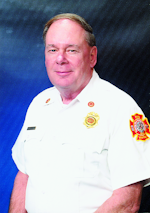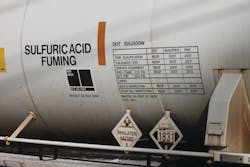Nearly every community, large and small, has hazardous materials transported through it or around it. The Emergency Planning and Community Right-To-Know Act of 1986 (EPCRA) mandates the creation of Local Emergency Planning Committees (LEPCs) to identify fixed facilities where extremely hazardous substances (EHS) are stored and used as well as transportation routes used to transport EHS.
Transportation incidents involving hazardous materials can be difficult to handle and even more difficult to plan for. One way of reducing the difficulty is to conduct a transportation commodity flow study. Such a study identifies the types of hazardous materials that are routinely transported on a particular route through or near a community. This knowledge assists emergency responders in planning for and dealing with incidents involving hazardous materials.
Keeping costs low
Consulting firms conduct commodity flow studies and prepare reports for local planners and emergency responders, but these studies cost money and there is no funding tied to EPCRA. Small amounts of money have been made available through the Hazardous Materials Emergency Preparedness Program (HMEP) for commodity flow studies, planning and training, but these funds may not be enough to pay a consultant to conduct a study.
It is possible to conduct a commodity flow study without spending a lot of money. Using trained volunteers from the community or existing agency staff helps ensure that an effective commodity flow study can be conducted with minimal expense. Some highway transportation routes and types of hazardous materials information can be obtained from trucking companies. Exact information about the material flowing through a community during a given period can be obtained through commodity flow studies.
One of the first tasks for personnel conducting commodity flow studies is to learn about the classification and placarding and labeling systems for hazardous materials used in transportation. The United Nations/Department of Transportation (UN/DOT) Classification System for Hazardous Materials categorizes the following:
• Explosives – Class 1. The symbol is an exploding sphere on an orange background and there are six subclasses. (Placards, other than radioactive, may not contain the words designating the hazard class; they may show only placard colors, symbols and subclass numbers.)
• Compressed Gas – Class 2. Flammable gas, poison gas or non-flammable non-poisonous gas. Flammable gas is a red placard with a flame symbol at the top. The non-flammable gas placard is green with a compressed gas cylinder symbol at the top. The poison gas placard is white with a skull and crossbones symbol at the top. This class has three subclasses.
• Flammable Liquid – Class 3. There are no subclasses in Class 3. Placards are red with a symbol of a flame at the top. A red placard means the material will burn under certain conditions.
• Flammable Solid – Class 4. Flammable solid, spontaneously combustible and dangerous-when-wet materials are included in this hazard class. The flammable solid placard has red and white vertical “candy” stripes with a flame at the top. The spontaneously combustible placard is white on the top half and red on the bottom half, with a flame symbol at the top. The dangerous-when-wet placard is blue with a flame symbol at the top. This hazard class has three subclasses.
• Oxidizer – Class 5. This class includes two subclasses – oxidizer and organic peroxide. These placards are yellow with the symbol of a flaming sphere at the top.
• Poison – Class 6. This class includes two subclasses – poison and infectious substance. The poison placard is white with a skull and crossbones at the top.
• Radioactive – Class 7. Placards list materials that carry the Radioactive III label. The placard is white on the top half and yellow on the bottom half. The radioactive propeller symbol is located at the top of the placard. The word Radioactive must appear on the placard. There are no subclasses.
• Corrosive – Class 8. This class contains both acids and bases. The placard is white on the top half and black on the bottom half. The hand and metal corrosion symbol is at the top. There are no subclasses. Acids and bases, while different chemically, have the same hazards.
• Miscellaneous Hazardous Materials – Class 9. This class contains materials not covered by other classes. The placard has black and white vertical stripes on the top half with a white bottom half. There are no subclasses.
The DOT Emergency Response Guide Book (ERG) can be useful to personnel doing a hazard analysis on chemicals identified in a traffic-placard survey. The ERG contains a listing of four-digit identification numbers found on the center of placards. The ERG will be most helpful to those personnel evaluating information collected and those involved in the planning process. Personnel should become familiar with those sections of the book that will assist them in performing their assigned tasks. Because of the limited time available to surveyors to view individual transportation vehicles as they go by a vantage point, it may not be as helpful to them during the actual survey.
Hazmats on highways
Vehicles transporting hazardous materials have number designations and carry certain types of materials on a regular basis. The ERG contains a chart showing silhouettes of the different highway transportation vehicles that carry hazardous materials.
MC/DOT 306/406 tankers are atmospheric pressure containers and have little or no pressure involved from the product. They are elliptical and typically carry gasoline, gasoline-and-ethanol mixes, diesel fuel and fuel oil. There will usually be a four-digit identification number in the center of the placard or on an orange rectangle near the placard on tank vehicles. The primary hazard of materials carried in these tankers is flammability.
MC/DOT 307/407 tankers are low pressure and may be insulated or uninsulated. Insulated tanks have a horseshoe shape when viewed from the rear. They carry a variety of hazardous materials including poisons, flammables and light corrosives.
MC/DOT 312/412 tankers are low pressure and carry very heavy liquids, so the tank diameter is small. There are heavy reinforcing rings around the outside of the tank. These tankers are used almost exclusively for corrosive liquids. The tanks may, however, be placarded oxidizer, flammable or corrosive.
MC 331 tankers are high-pressure tanks carrying liquefied compressed gases with high liquid-to-gas expansion ratios. The tanks have rounded ends with no insulation and appear to be large “bullets on wheels.” Most contents are flammable, but non-flammable and poisonous materials may also be transported in these tanks.
MC 338 tankers carry cryogenic liquids; gases that have been liquefied for transportation. The tanks may have a box on the back where the transfer pump is located. All 338 tankers will have a silver series of fins and tubes underneath the tank. This is the heat exchanger and sets the 338 apart from other types of tankers. The liquids have temperatures below –130 degrees Fahrenheit, some as low as –452 degrees F. The materials inside may be inert, flammable, oxidizer or poison.
Box trailers may carry any of the hazard classes of hazardous materials. The placarding requirements are based upon the hazard present and the weight of the hazardous materials. Table 1 materials must be placarded regardless of quantity. Table 2 materials are placarded if there is 1,001 pounds aggregate weight of two or more of the materials in the shipment. For this reason it is important to get an accurate count of unplacarded box trailers so that planners can estimate the number that may be hauling hazardous materials by using the national average percentages. Trucking company names may also be helpful to obtain information on hazardous materials typically carried through a given area.
The DOT believes that 50% of all highway vehicles are transporting hazardous materials, but it is thought that only half of those are required to be placarded because of weight requirements. The “Dangerous” placard may also appear on box trailers. Tube trailers are high-pressure tanks up to 3,000 psi. These tanks carry compressed gases. There are no liquids in the tanks. These gases may be flammable, non-flammable, oxidizers or poisons. The tanks can be recognized by the number of small individual tanks that appear to be stacked on a flat bed trailer and banded together.
Rail transportation
Many of the same types of products shipped by highway are also shipped on the rail. Rail shipments involve greater quantities than in highway containers and multiple containers in the same train.
Rail tank cars are either pressure or non-pressure. Pressure cars have no valves showing on the tank top or dome cover. If valves or piping are showing, it is a liquid car. Rail cars must be placarded regardless of the quantity of hazardous materials in the car. The same types of placards used on the highway are also used on rail cars.
Conducting a study
To begin a commodity flow studies, following training of personnel, determine major interstate, federal, state and local highways. Most of the same major routes used for travel are also used for shipments of hazardous materials. Information may be available from the state department of transportation, the carrier enforcement department of the state law enforcement agency or trucking companies.
If hazardous materials are found to be transported on a particular route, chances are they will be transported on that route on a regular basis. If railroads pass through a community or response jurisdiction, commodity flow studies can be conducted on rail transportation of hazardous materials using the same training and tools as for highway transportation.
Forms can be developed to facilitate fast recording of information – in most cases, vehicles and trains will not stop to let you gather information, so you must be quick. Photos of transportation vehicles or rail cars may also be a way to obtain information and you can use the photos to conduct your study report. Tanker trucks carrying hazardous materials will almost always be marked or placarded.
Here is a checklist of tips and information to help in conducting a placard survey of transportation routes:
• Work from a safe location
• Count all box trailers and intermodal containers on the highway
• Note highway vehicles with placards
• Note trucking company names
• Note stenciled commodity names
• Note type of container/tank whether pressure or non-pressure
Railcars are required to be placarded, regardless of the quantity of hazardous material present. That requirement makes a survey of the railroad easier to do.
• Identify the cars with placards
• Note the type of car; i.e., box car, pressure tanker, liquid tanker
• Note any stenciling of names on tank cars
• List any markings on railcars, such as names of manufacturers, chemical companies, etc.

Robert Burke
ROBERT BURKE, who is a hazardous materials and fire protection consultant and a Firehouse contributing editor, is a Certified Fire Protection Specialist (CFSP), Fire Inspector II, Fire Inspector III, Fire Investigator and Hazardous Materials Specialist. He has served on state and county hazmat teams. Burke is the author of the textbooks "Hazardous Materials Chemistry for Emergency Responders," "Counter-Terrorism for Emergency Responders," "Fire Protection: Systems and Response," "Hazmat Teams Across America" and "Hazmatology: The Science of Hazardous Materials." He can be contacted at [email protected].






